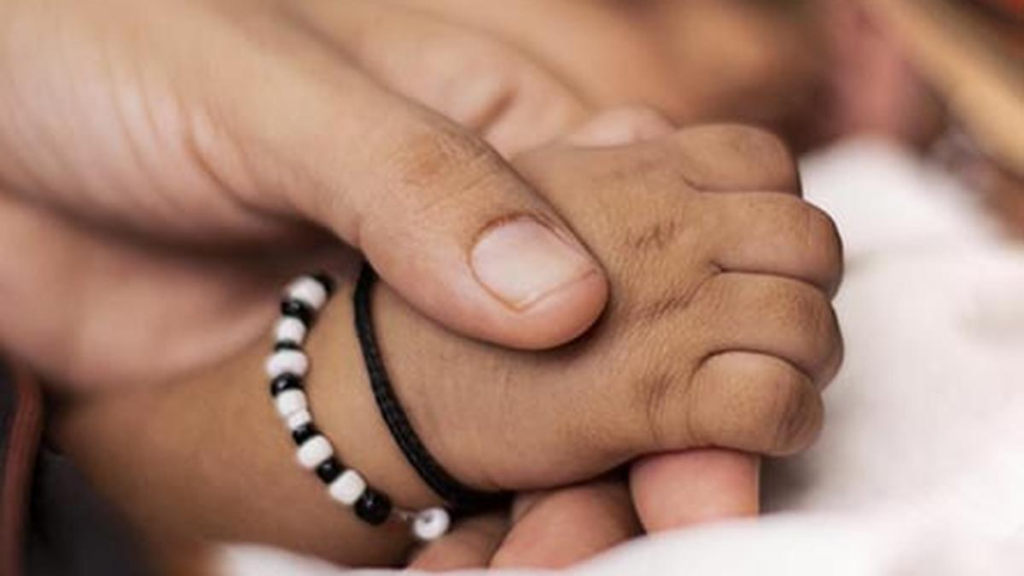| UPSC Relevance Prelims 🟡 Constitutional Provisions: Article 21 (Right to life), Article 39(e) (child protection). 🟡International Conventions: UN Convention on the Rights of the Child. Mains – GS Paper II 🟡Governance: Role of statutory bodies (Human Rights Commissions), failure of public institutions. 🟡Justice: Issues in public health delivery, child rights, and disability. 🟡Ethics Case Study: Handling a medical crisis with empathy, institutional responsibility. Mains – GS Paper IV (Ethics) 🟡Topics: Medical ethics, public service accountability, rights-based service delivery. |
Why in News?
The Haryana Human Rights Commission has taken suo motu cognisance of a shocking case where a newborn’s arm was completely severed during delivery at a government hospital in Nuh district on July 30, 2025. The incident has sparked outrage, raising serious questions about medical negligence, institutional accountability, and child rights violations.
Background
- Victim: Sarjeena, the mother, was admitted to Mandi Khera Civil Hospital, Nuh.
- Incident: During delivery, the newborn’s arm was completely severed, indicating a gross procedural lapse.
- Response: The Haryana Human Rights Commission (HHRC) termed it a violation of:
- UN Convention on the Rights of the Child (UNCRC)
- Right to health and life under Article 21 of the Indian Constitution

Legal and Constitutional Dimensions
1. Right to Health under Article 21
- The Supreme Court has interpreted right to health as an integral part of the right to life.
- Failure to ensure safe childbirth constitutes a constitutional violation.
2. UNCRC Obligations
- India ratified the UN Convention on the Rights of the Child in 1992.
- Article 6 & 24 guarantee the child’s right to survival, development, and access to healthcare.
3. Medical Negligence and Tort Law
- If proven, the act may amount to medical negligence, actionable under:
- Consumer Protection Act
- Indian Penal Code (IPC), Sections 304A (causing death by negligence), 338
Ethical and Administrative Issues
1. Violation of Medical Ethics
- Medical professionals are bound by the Hippocratic Oath and Indian Medical Council (Professional Conduct) Regulations, 2002.
- The act shows a breach of duty of care, especially towards vulnerable lives.
2. Erosion of Public Trust
- The incident highlights how systemic lapses in public hospitals damage trust in state healthcare institutions.
- Particularly serious in underserved areas like Nuh, where private healthcare is inaccessible.
Health System Gaps Exposed
1. Lack of Trained Manpower
- Rural areas like Nuh suffer from shortage of skilled obstetricians, nurses, and emergency care facilities.
2. Failure of Standard Operating Procedures (SOPs)
- Possible non-adherence to safe delivery protocols, particularly in complicated cases (e.g., breech birth, premature labour).
3. Infrastructure Deficiency
- Many Community Health Centres (CHCs) lack:
- Emergency obstetric care (EmOC)
- Functional delivery rooms
- Neonatal Intensive Care Units (NICU)
Government and Institutional Response
1. Haryana Human Rights Commission’s Action
- Directed the Civil Surgeon of Nuh to submit:
- Detailed medical report
- Circumstances of delivery
- Treatment and rehabilitation plans
2. Need for Medical Audit
- Such incidents call for third-party medical audits to:
- Investigate lapses
- Recommend corrective steps
- Penalise erring staff
3. Legal Redress for the Family
- Compensation, rehabilitation of the child, and psychological support must be ensured.
Broader Implications
For Public Health Governance:
- Reinforces the need for quality control and accountability mechanisms in public hospitals.
For Human Rights:
- Reflects the continuing neglect of health as a human right, especially for the marginalised.
For Policy Implementation:
- Underlines gaps in schemes like:
- Janani Suraksha Yojana (JSY)
- LaQshya Programme (Labour Room Quality Improvement Initiative)
- National Health Mission (NHM)
Way Forward
1. Accountability and Grievance Redressal
- Fast-track investigation and prosecution under IPC or Medical Council laws
- Establish District-level Patient Safety Cells with time-bound grievance mechanisms
2. Strengthening Rural Healthcare
- Fill human resource gaps through:
- Incentives for rural posting
- Midwifery training programs
- Public-private partnerships
3. Audit and Monitoring Mechanisms
- Regular quality audits of delivery wards, especially in high-risk districts
- Display patient rights prominently in facilities
4. Child and Maternal Rights Awareness
- Conduct community awareness campaigns on maternal entitlements and complaint mechanisms
5. Use of Technology
- Implement telemedicine consultations for complicated cases
- Digital documentation of procedures to ensure transparency
Conclusion
The Nuh newborn case reflects a deep crisis in public healthcare ethics, accountability, and rights enforcement. For a welfare state, ensuring safe childbirth is a basic obligation. This incident should not be treated as an isolated lapse but as a wake-up call for systemic reforms to protect the most vulnerable—newborns and mothers.
| State Human Rights Commission (SHRC) About State Human Rights Commission (SHRC) Introduction The State Human Rights Commission (SHRC) is a statutory body constituted under the Protection of Human Rights Act, 1993 to protect and promote human rights at the state level. Currently, 26 states in India have established SHRCs. Jurisdiction Can inquire into human rights violations related to subjects under the State List and Concurrent List (Seventh Schedule). Cannot operate in Union Territories, including Delhi (handled by NHRC). May act on: Suo motu basis Petitions Court orders Composition 🟡Chairperson: Retired Chief Justice or Judge of a High Court. 🟡Members (2): 🟡High Court/District Court judge (with 7+ years’ experience) 🟡Expert in human rights Appointment & Tenure 🟡Appointed by the Governor on recommendation of a committee led by the Chief Minister. 🟡Term: 3 years or until 70 years of age (whichever is earlier). 🟡Can only be removed by the President. 🟡Salaries decided by the state government, but not alterable post-appointment. Powers and Procedure 🟡Has powers of a civil court. 🟡Regulates its own procedures. 🟡Cannot inquire into matters after 1 year from the date of alleged violation. 🟡Can summon reports from the state government or authorities. Functions 1 -Inquire into human rights violations or failure of public servants to prevent them. 2 – Intervene in court proceedings involving human rights violations. 3 – Visit jails/detention centres and recommend improvements. 4 – Review laws and constitutional safeguards and recommend changes. 5 – Study and address factors (e.g. terrorism) hindering human rights. 6 -Promote human rights research and awareness. Post-Inquiry Actions Recommend: 🔵Compensation to victims 🔵Prosecution or action against the guilty 🔵Interim relief 🟡May move High Court or Supreme Court for suitable relief. 🟡Submits annual/special reports to state government, which are tabled in the state legislature. Human Rights Courts 🟡Established in each district for speedy trials. 🟡Created by state government with Chief Justice’s concurrence. 🟡Special public prosecutors are appointed for these courts. |
UPSC Prelims practice Questions
1. Consider the following statements regarding Human Rights Commissions in India:
- State Human Rights Commissions are constitutional bodies established under Article 338.
- They can take suo motu cognisance of incidents of human rights violations.
- The National Human Rights Commission is chaired by the Chief Justice of India.
Which of the statements given above is/are correct?
A. 2 only
B. 1 and 3 only
C. 1 and 2 only
D. 2 and 3 only
Answer: A. 2 only
Mains question-
Q.Childbirth complications and maternal care remain neglected in India’s rural healthcare system.Evaluate the policy measures aimed at improving maternal and neonatal care in India. What more needs to be done to bridge the quality gap in public hospitals? (15 marks)
SOURCE- THE HINDU
Found this helpful?
Bookmark for revision, Practice the mains question, and
Share with fellow aspirants! THANK YOU
